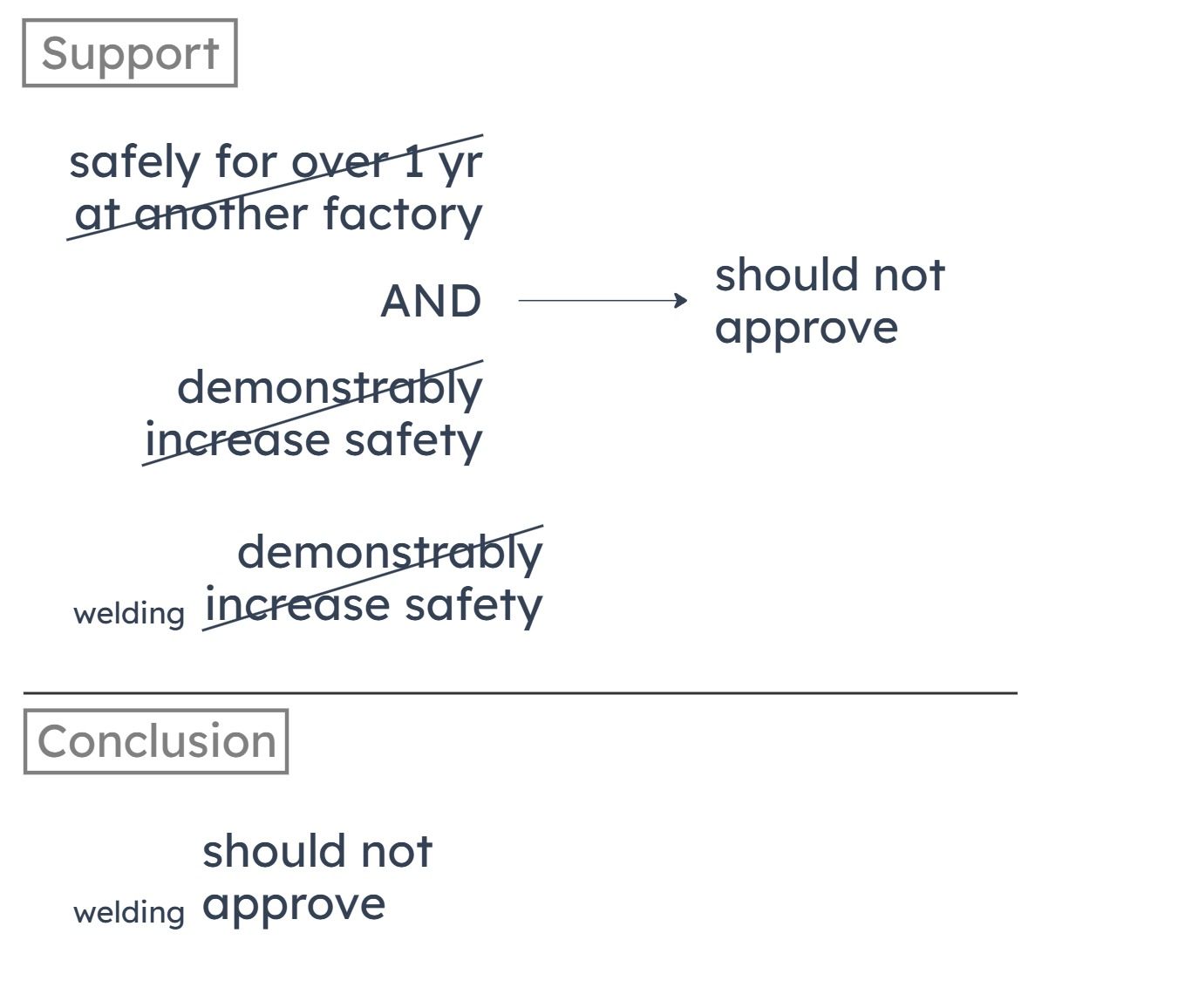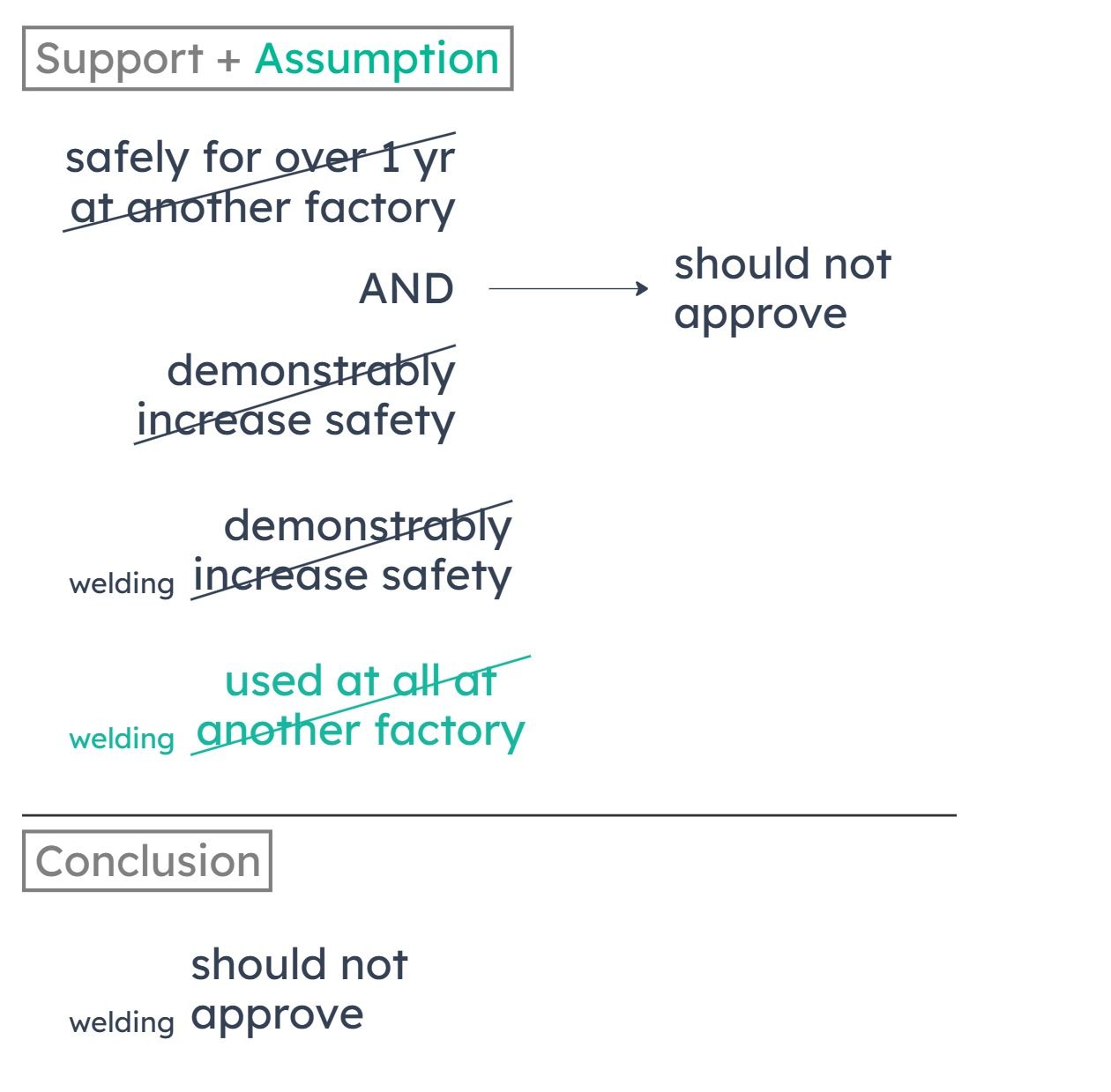LSAT 143 – Section 3 – Question 12
LSAT 143 - Section 3 - Question 12
June 2015You need a full course to see this video. Enroll now and get started in less than a minute.
Target time: 1:15
This is question data from the 7Sage LSAT Scorer. You can score your LSATs, track your results, and analyze your performance with pretty charts and vital statistics - all with a Free Account ← sign up in less than 10 seconds
| Question QuickView |
Type | Tags | Answer Choices |
Curve | Question Difficulty |
Psg/Game/S Difficulty |
Explanation |
|---|---|---|---|---|---|---|---|
| PT143 S3 Q12 |
+LR
| Sufficient assumption +SA Conditional Reasoning +CondR Rule-Application +RuleApp | A
10%
158
B
86%
165
C
2%
154
D
2%
153
E
0%
154
|
140 148 156 |
+Medium | 147.721 +SubsectionMedium |
J.Y.’s explanation
You need a full course to see this video. Enroll now and get started in less than a minute.
Application: The safety inspector should not approve the proposed new welding process, for it cannot be shown to increase safety at the factory.
Summary
The conclusion is that the factory’s safety inspector should not approve the proposed new welding process. This is based on the following:
In order for it to be appropriate to approve a new manufacturing process, it must (1) have been used safely for more than a year at another factory, OR (2) demonstrably increase safety at the factory at which the process will be implemented.
The new welding process can’t be shown to increase safety at the factory.

In order for it to be appropriate to approve a new manufacturing process, it must (1) have been used safely for more than a year at another factory, OR (2) demonstrably increase safety at the factory at which the process will be implemented.
The new welding process can’t be shown to increase safety at the factory.

Missing Connection
We know requirement (2) can’t be satisfied. But (1) might still be satisfied, in which case, it might be appropriate to approve the new welding process. To establish that the new welding process should NOT be approved, then, we want to establish that requirement (1) can’t be met, either. We want an answer that proves the new process has NOT been used safely for more than a year at another factory.
A
The factory at which the new welding process was first introduced has had several problems associated with the process.
This doesn’t establish that the new process hasn’t been used safely at another factory. First, we don’t know whether the “problems” in (A) are safety problems. Second, even if they are, the process could have been used safely at another factory besides the one at which the process was first introduced.
B
The proposed new welding process has not been used in any other factory.
(B) establishes that the new process has not been used safely for more than a year at another factory. After all, if it’s never been used in another factory, then it must be true that it hasn’t been used safely (or unsafely) at another factory.

C
Some of the manufacturing processes currently in use at the factory are not demonstrably safer than the new welding process.
How the new process compares to current processes has nothing to do with the policy that we’re trying to apply. (C) doesn’t establish that the new process hasn’t been used safely more than a year at another factory.
D
The safety inspector will not approve any new process that has not been used extensively elsewhere.
What the safety inspector will not approve has nothing to do with whether they SHOULD approve the new process. (D) doesn’t establish that the new process has not been used safely for more than a year at another factory.
E
The proposed new welding process has been used in only one other factory.
If that process has been used safely at that one factory, then it might be appropriate to approve the process. (E) does not establish that the new process has not been used safely for more than a year at another factory.
Take PrepTest
Review Results
LSAT PrepTest 143 Explanations
Section 1 - Logical Reasoning
- Question 01
- Question 02
- Question 03
- Question 04
- Question 05
- Question 06
- Question 07
- Question 08
- Question 09
- Question 10
- Question 11
- Question 12
- Question 13
- Question 14
- Question 15
- Question 16
- Question 17
- Question 18
- Question 19
- Question 20
- Question 21
- Question 22
- Question 23
- Question 24
- Question 25
Section 2 - Reading Comprehension
- Passage 1 – Passage
- Passage 1 – Questions
- Passage 2 – Passage
- Passage 2 – Questions
- Passage 3 – Passage
- Passage 3 – Questions
- Passage 4 – Passage
- Passage 4 – Questions
Section 3 - Logical Reasoning
- Question 01
- Question 02
- Question 03
- Question 04
- Question 05
- Question 06
- Question 07
- Question 08
- Question 09
- Question 10
- Question 11
- Question 12
- Question 13
- Question 14
- Question 15
- Question 16
- Question 17
- Question 18
- Question 19
- Question 20
- Question 21
- Question 22
- Question 23
- Question 24
- Question 25
Section 4 - Logical Reasoning
- Question 01
- Question 02
- Question 03
- Question 04
- Question 05
- Question 06
- Question 07
- Question 08
- Question 09
- Question 10
- Question 11
- Question 12
- Question 13
- Question 14
- Question 15
- Question 16
- Question 17
- Question 18
- Question 19
- Question 20
- Question 21
- Question 22
- Question 23
- Question 24
- Question 25
- Question 26
Leave a Reply
You must be logged in to post a comment. You can get a free account here.